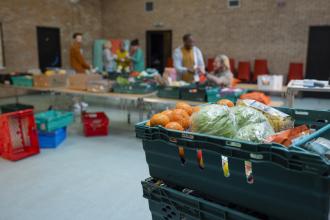Impacts of food security on nutrition
The 2020 Nobel Peace Prize was awarded to the World Food Programme (WFP) on 9 October 2020, thrusting the global plight of food insecurity and hunger back into the international spotlight.[1] After 2 decades of improvements, the rate of global hunger began increasing again in 2015. Last year, it was estimated that almost 690 million people worldwide struggled with chronic hunger.[2] Devastatingly, 2020 will see even more people struggle to access healthy nutrition as the social and economic impacts of the COVID-19 pandemic compound the global hunger crisis.[2]
Nearly 9% of the world’s population has insufficient nutrition, but it is not only the lack of food that can lead to poor health in a population. Poor diet can lead to overweight and obesity as well to undernutrition.[2] The daily cost of a healthy diet has been estimated to be at least 5 times more expensive than one that is made up primarily of starches.[2] Additionally, adults with household food insecurity also have higher rates of health care utilization and costs.[3] The State of Food Security and Nutrition in the World report highlights the global need to ensure our interconnected food systems are transformed to yield affordable, accessible, and nutritious diets.[2]
As a family physician with a practice focused on obesity medicine, I have heard many patients relate their struggles to achieve a healthy diet. They report cost as a barrier when selecting fresh proteins, fruits, and vegetables at the store. They recognize the additional time cost when provided with well-meaning advice to prioritize home-cooked meals. Others report spending money on untested diet treatments or quick fixes, leaving little in the budget for the grocery store. Ultraprocessed foods can be cheaper, highly marketed, more addictive, and more accessible than their unprocessed counterparts, making them hard to resist and quickly adding additional costs to a household grocery budget.
Transforming food systems can feel mountainous, but there is much we can do as clinicians on an individual basis. Ask about the stability in your patients’ lives with regard to food and financial security. Who does the shopping? Who does the cooking? These simple queries can be brief and yield good information when it comes to troubleshooting barriers to healthy nutrition.
Common strategies for helping patients achieve a healthy diet at lower cost[4] include:
- Batch cooking meals at home and freezing portions.
- Choosing frozen vegetables over more expensive fresh ones.
- Using coupons and planning ahead when shopping.
- Using new apps, such as Flashfood, to identify fresh products, nearing their best-before dates, at bargain prices at local supermarkets.
Having patients do a simple calculation of the money they’ve spent over 1 week on take-out, coffees, fast food, and grocery store junk food can be eye opening and help them find more room in their budget for more nutritious, whole foods. Local supports such as food banks (www.foodbanks.ca) can also help in a time of need, as can provincial and federal nutrition benefits programs that may provide additional nutritional and diet supports for some patients.[5] HealthLink BC also offers telephone and email support with registered dietitians (www.healthlinkbc.ca/dietitian-services) through the 8-1-1 service.
Household food insecurity affects 12% of Canadians and millions of people around the globe.[3] We can help our patients navigate healthy eating on a budget individually and advocate globally for transformative change to the food systems that nurture the world.
—Kelsey D.M. Kozoriz, MSc, MD, CCFP
American Board of Obesity Medicine Diplomate
hidden
This article is the opinion of the Nutrition Committee, a subcommittee of Doctors of BC’s Council on Health Promotion, and is not necessarily the opinion of Doctors of BC. This article has not been peer reviewed by the BCMJ Editorial Board.
References
1. The Nobel Foundation. The Nobel Peace Prize for 2020. Accessed 14 October 2020. www.nobelprize.org/prizes/peace/2020/press-release.
2. Food and Agriculture Organization of the United Nations. The state of food security and nutrition in the world, 2020. Accessed 21 October 2020. www.fao.org/3/ca9692en/online/ca9692en.html.
3. Tarasuk V, Cheng J, de Oliveira C, et al. Association between household food insecurity and annual health care costs. CMAJ 2015;187:E429-E436.
4. HealthLinkBC. Quick tips: Healthy eating on a budget, 2019. Accessed 14 October 2020. www.healthlinkbc.ca/health-topics/zx3463.
5. HealthLinkBC. Overview of BC Provincial and Federal Nutrition Benefits Programs, 2019. Accessed 14 October 2020. www.healthlinkbc.ca/healthy-eating/nutrition-benefits-programs.

